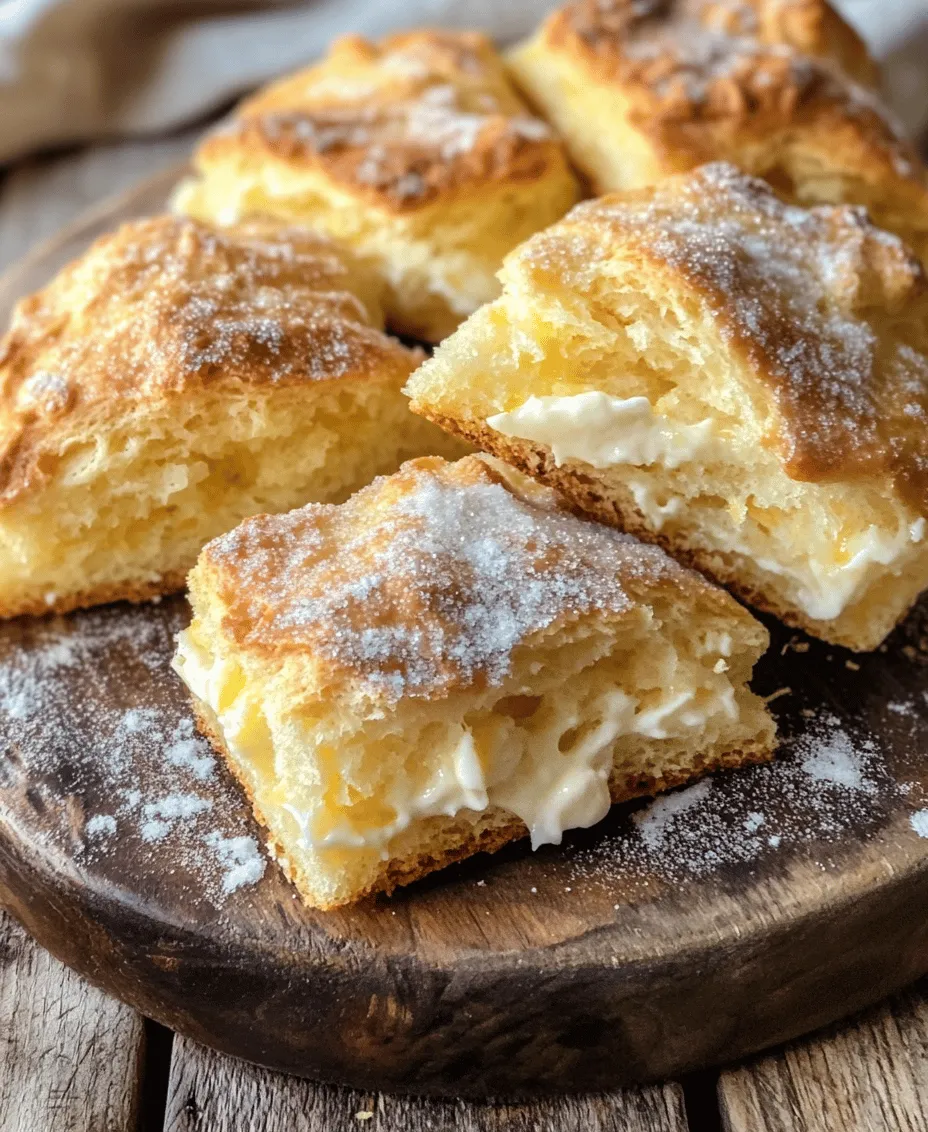Introduction
Scones are an iconic baked good that have earned a cherished spot in tea time traditions and breakfast menus around the world. These delightful pastries, with their crisp exterior and tender crumb, can be enjoyed in a myriad of flavors—from classic buttermilk to innovative fruit-infused varieties. Among the many flavors that elevate the humble scone, lemon shines as a particularly refreshing choice, providing a burst of citrusy brightness that delights the palate.
In this article, we will explore the art of crafting Luscious Lemon Cream Scones, a recipe that combines the rich, buttery goodness of traditional scones with the invigorating tang of fresh lemons. Perfect for a cozy brunch or an afternoon tea gathering, these scones are sure to impress with their light texture and zesty flavor. We will delve into the history of scones, the essential ingredients that make up this delectable treat, and provide you with step-by-step instructions to guide you through the process of making these lemon-flavored delights.
Understanding Scones
What Are Scones?
Scones are a type of quick bread that originated in the United Kingdom, typically made with wheat flour, baking powder, salt, butter, and milk or cream. They are often served as part of a traditional afternoon tea, where they are accompanied by clotted cream and jam. The texture of a scone can range from flaky and crumbly to soft and cake-like, depending on the method of preparation and the ingredients used.
A Brief History of Scones
The history of scones dates back to the early 16th century, with some accounts suggesting that they were first created in Scotland. The name “scone” is believed to be derived from the “Stone of Scone,” a symbol of Scottish royalty. Originally, scones were made with oats and baked on a griddle, but over time, the recipe evolved to include flour and baking powder, making them lighter and more versatile.
Today, scones are enjoyed worldwide and have inspired countless variations. From sweet to savory, and from fruit-studded to cheese-laden, there’s a scone for every taste preference. The introduction of flavors like lemon not only adds a refreshing twist but also embodies the spirit of creativity that defines modern baking.
The Appeal of Lemon in Baking
Lemon is a popular ingredient in baking, and for good reason. Its bright, tangy flavor and fragrant aroma can elevate a variety of baked goods, adding a burst of freshness that balances sweetness. In the context of scones, lemon zest and juice work harmoniously with the rich, buttery base, creating an irresistible contrast that tantalizes the taste buds. The acidity of lemon also helps to enhance the flavors of other ingredients, making it an essential component in many recipes.
Ingredients Breakdown
To create Luscious Lemon Cream Scones, you will need several key ingredients, each playing a crucial role in achieving the perfect texture and flavor.
1. All-Purpose Flour
All-purpose flour serves as the foundation of the scone, providing the necessary structure and texture. It contains a moderate level of protein, which helps create a tender crumb when combined with the right amount of liquid. For the best results, be sure to measure the flour accurately, as too much can lead to dense scones.
2. Granulated Sugar
Granulated sugar contributes sweetness to the scone while also aiding in the creation of a golden crust. The sugar dissolves during baking, enhancing the overall flavor profile and providing a slight caramelization on the surface, which is both visually appealing and delicious.
3. Baking Powder
Baking powder is the leavening agent in this recipe, responsible for giving the scones their light and fluffy texture. It releases carbon dioxide gas during baking, causing the dough to rise. For optimal results, ensure that your baking powder is fresh, as expired leavening agents will not work effectively.
4. Salt
Salt is a critical ingredient in any baked good, as it enhances the flavors of the other ingredients. A small amount of salt helps to balance the sweetness of the sugar and the richness of the butter, resulting in a more complex flavor profile.
5. Unsalted Butter
Unsalted butter adds richness and flakiness to the scones. It is important to use cold unsalted butter, as this prevents it from melting into the dough before baking. When cold butter is cut into the dry ingredients, it creates pockets of fat that contribute to the flaky texture of the finished scone.
6. Heavy Cream
Heavy cream provides moistness and creaminess to the scone dough. It also aids in creating a tender crumb, as the fat content in heavy cream adds richness. The use of cream instead of milk is a hallmark of cream scones, resulting in a more decadent treat.
7. Lemon Zest and Juice
Fresh lemon zest and juice are the stars of this recipe, infusing the scones with vibrant flavor. The zest contains essential oils that provide a concentrated lemon aroma, while the juice adds acidity and brightness. Together, they create a harmonious balance that enhances the overall taste experience.
8. Vanilla Extract
Vanilla extract adds depth to the flavor of the scones, complementing the brightness of the lemon. The warm, sweet notes of vanilla elevate the overall flavor profile, creating a well-rounded baked good.
9. Egg Wash
An egg wash, made from a beaten egg, is brushed onto the scones before baking to achieve a golden finish. This step not only enhances the appearance of the scones but also adds a slight sheen to the crust.
Step-by-Step Instructions
Before diving into the preparation of your Luscious Lemon Cream Scones, it is essential to prep your kitchen for a smooth baking experience.
Prepping the Kitchen
1. Preheat the Oven: Start by preheating your oven to 400°F (200°C). A hot oven is crucial for creating the perfect rise in your scones, resulting in a light and fluffy texture.
2. Prepare Baking Sheet: Line a baking sheet with parchment paper. This will prevent the scones from sticking and make for easy cleanup once they are baked.
3. Gather Ingredients: Assemble all the ingredients needed for the recipe. Having everything at your fingertips will streamline the process and ensure that you don’t miss any crucial steps.
By understanding the ingredients and prepping your kitchen, you are well on your way to crafting delicious Luscious Lemon Cream Scones that will brighten up any meal. The next steps will guide you through the mixing, shaping, and baking processes, ensuring a delightful outcome that is bursting with lemony goodness. Stay tuned for the continuation of this recipe, where we will dive deeper into the step-by-step instructions needed to achieve scone perfection.

Mixing Dry Ingredients: Tips for Proper Whisking
The foundation of any great scone begins with the dry ingredients. In this recipe, you will typically need all-purpose flour, baking powder, sugar, and a pinch of salt. Whisking these ingredients together is essential for ensuring even distribution of the baking powder and sugar, which will help your scones rise properly and achieve a light texture.
To whisk effectively, use a large bowl and a whisk or fork, making sure to aerate the flour as you mix. This helps to eliminate any lumps and ensures that the baking powder is evenly distributed. Aim for a combination that is light and fluffy, which can be achieved by whisking vigorously for about 30 seconds to a minute. This simple step can make a significant difference in the final texture of your scones.
Incorporating Butter: Techniques for Achieving the Right Texture
Incorporating cold butter into your dry ingredients is a crucial step in scone-making. The cold butter creates pockets of fat within the dough, which leads to flaky layers once baked. To achieve the right texture, start by cutting the butter into small cubes (about 1/2 inch).
Add the cold butter cubes to the dry ingredients and use a pastry cutter, two forks, or even your fingers to work the butter into the flour. The goal is to break down the butter until the mixture resembles coarse crumbs, with some pea-sized butter pieces still visible. Be careful not to overwork the dough; you want to maintain those little chunks of butter for optimal flakiness.
Creating the Lemon Cream Mixture: Balancing Flavor and Moisture
Next, it’s time to create the lemon cream mixture, which provides both flavor and moisture to your scones. In a separate bowl, combine heavy cream, fresh lemon juice, and lemon zest. The heavy cream adds richness, while the lemon juice and zest impart that delightful citrus flavor that defines these scones.
To balance the flavor, consider tasting the cream mixture before adding it to your dry ingredients. If you find it too tart, you can adjust by adding a teaspoon or two of sugar. Mix the ingredients gently until just combined, ensuring that the lemon flavor is present but not overpowering.
Combining Wet and Dry Ingredients: Key to Avoid Overmixing
When it comes to combining your wet and dry ingredients, the key is to avoid overmixing. Add the lemon cream mixture to the bowl of dry ingredients and use a spatula or wooden spoon to gently fold them together. Mix until you see no dry flour remaining, but stop as soon as the dough comes together.
Overmixing can lead to tough scones, which is something we want to avoid. The dough should be slightly sticky but manageable. If it feels too wet, you can sprinkle a bit more flour onto a work surface before shaping the dough.
Shaping the Dough: Techniques for Cutting Scones
Once your dough has come together, it’s time to shape it. Turn the dough onto a lightly floured surface and gently pat it into a rectangle about 1-inch thick. This thickness is crucial for achieving the right rise during baking.
To cut the scones, use a sharp knife or a bench scraper to slice the dough into triangles or squares, depending on your preference. If you want round scones, use a biscuit cutter, pressing straight down without twisting to ensure a clean cut. Place the cut scones onto a parchment-lined baking sheet, leaving a bit of space between them to allow for expansion.
Preparing for Baking: Egg Wash and Sugar Sprinkle
For an extra touch of rich color and flavor, brush each scone with an egg wash. To make an egg wash, beat one egg with a tablespoon of milk or cream and then use a pastry brush to apply it to the tops of the scones. This creates a beautiful golden crust when baked.
You can also sprinkle a little sugar on top for added sweetness and texture. Coarse sugar works particularly well for this purpose, giving the scones a delightful crunch once they are baked.
Baking Process: What to Look for During Baking
Preheat your oven to 400°F (200°C) before baking your scones. Place the baking sheet in the oven and bake for about 15-20 minutes. Keep an eye on them as they bake – you want to look for a light golden color on the tops and sides. The scones should rise nicely, showcasing their flaky layers.
To check for doneness, you can gently tap the top of a scone; it should feel firm to the touch. If you have a thermometer, the internal temperature should be around 200°F (93°C) when they are fully baked. Remove the scones from the oven and let them cool on a wire rack for a few minutes before serving.
Tips for Perfecting Your Scones
– The Importance of Using Cold Butter: Using cold butter is critical for achieving flaky scones. It prevents the butter from melting into the dough before baking, allowing the steam from the butter to create those coveted layers.
– Best Practices for Measuring Flour: For accurate flour measurement, spoon the flour into your measuring cup without packing it down, then level it off with a knife. This prevents your scones from becoming dense.
– Variations: Feel free to customize your scones by adding in fruits like blueberries or cranberries, nuts such as walnuts or pecans, or spices like cinnamon for a unique twist. These variations can enhance the flavor and texture while keeping the basic lemon cream flavor intact.
– How to Store Leftover Scones for Freshness: To keep your scones fresh, store them in an airtight container at room temperature for up to 2 days. If you want to keep them longer, you can freeze them for up to a month. Just make sure to wrap them tightly in plastic wrap and place them in a freezer bag.
Serving Suggestions
Lemon cream scones are delightful on their own, but you can elevate the experience with a few ideal pairings. Clotted cream and fresh lemon curd are perfect accompaniments, adding a luxurious touch that complements the zesty flavors of the scones.
For a more creative approach, consider serving your scones as part of a lavish brunch spread. Pair them with a selection of teas, fruit preserves, and a light salad for a delightful afternoon tea or brunch gathering.
When presenting your scones, arrange them on a tiered cake stand or a rustic wooden platter. Garnish with lemon slices or sprigs of fresh mint for a beautiful display that will impress your guests.
Nutritional Information
While lemon cream scones are undoubtedly indulgent, they can fit into a balanced diet when enjoyed in moderation. Each serving typically contains carbohydrates for energy, fats from the butter and cream for richness, and proteins from the egg wash and cream.
To make this recipe slightly healthier, consider substituting some of the all-purpose flour with whole wheat flour, which adds fiber and nutrients. Additionally, using less sugar or opting for a natural sweetener can reduce the overall calorie count while still maintaining flavor.
Conclusion
Making luscious lemon cream scones can be a delightful and rewarding experience. With their tender, flaky texture and bright citrus flavor, these scones are perfect for any occasion, from a cozy morning coffee to an elegant afternoon tea.
In baking, there’s a unique connection that draws people together, creating cherished memories shared over warm, homemade treats. We encourage you to try your hand at this recipe; not only will you enjoy the process, but you’ll also share the joy of scone-making with family and friends.
So gather your ingredients, follow these detailed steps, and savor the luscious taste of freshly baked lemon cream scones. Happy baking!

